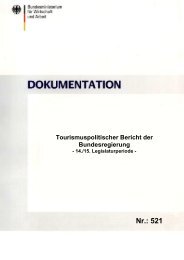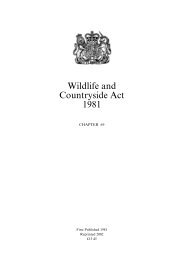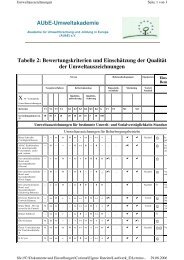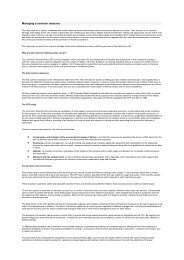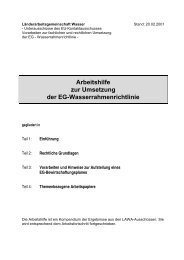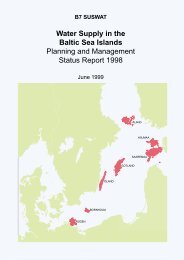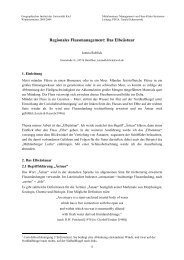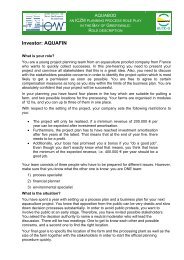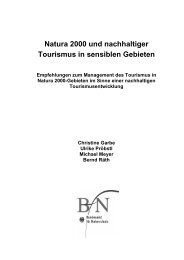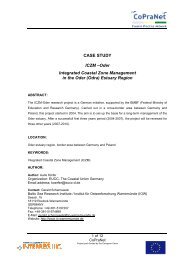The European environment - State and outlook ... - IKZM-D Lernen
The European environment - State and outlook ... - IKZM-D Lernen
The European environment - State and outlook ... - IKZM-D Lernen
You also want an ePaper? Increase the reach of your titles
YUMPU automatically turns print PDFs into web optimized ePapers that Google loves.
Introduction<br />
More recently, the EEA has analysed extensively the use<br />
of market-based instruments in <strong>environment</strong>al policy<br />
making across Europe. <strong>The</strong>se cover <strong>environment</strong>al<br />
taxes, charges, subsidies <strong>and</strong> trading permits, amongst<br />
others. <strong>The</strong> analysis has been used extensively in Part<br />
A <strong>and</strong> especially in the final chapter on how the use<br />
of market measures in <strong>environment</strong>al policy could be<br />
exp<strong>and</strong>ed in future years. Two reports on market-based<br />
instruments are in the publication process.<br />
4 Policy context<br />
Since the previous five year state <strong>and</strong> <strong>outlook</strong> report<br />
in 1999 there have been a wide range of policy<br />
developments that provide, to differing degrees,<br />
relevant contexts for the assessments presented in<br />
this report. Four developments merit particular<br />
consideration: the enlargement of the <strong>European</strong> Union<br />
to 25 Member <strong>State</strong>s in May 2004, the 6th <strong>environment</strong><br />
action programme adopted in July 2002, the EU<br />
sustainable development strategy adopted in June 2001;<br />
<strong>and</strong> the Lisbon strategy adopted in March 2000.<br />
<strong>The</strong> enlargement of the EU has brought a unique set of<br />
new <strong>environment</strong>al assets — including rich biodiversity<br />
<strong>and</strong> l<strong>and</strong>scapes <strong>and</strong> vast areas of relative wilderness<br />
— but also represents an important challenge for EU<br />
<strong>environment</strong>al policy given the capacity building <strong>and</strong><br />
financing needs required to support implementation<br />
of the acquis communitaire. <strong>The</strong> report does not deal<br />
with the implications of enlargement as a separate<br />
issue. <strong>The</strong> main challenges are instead addressed across<br />
the chapters in Part A. <strong>The</strong> progressive adoption by<br />
the EU-10 Member <strong>State</strong>s of the <strong>environment</strong> acquis<br />
has already contributed to an enhanced <strong>environment</strong><br />
in many places <strong>and</strong> where there are opportunities<br />
for mutual learning about better policy design <strong>and</strong><br />
implementation.<br />
<strong>The</strong> 6th EAP sets out the EU's <strong>environment</strong>al roadmap<br />
for the 10 years to 2012. It is the main vehicle by which<br />
to achieve the <strong>environment</strong>al goals of the sustainable<br />
development strategy. It sets ambitious, long-term<br />
goals for <strong>environment</strong>al protection <strong>and</strong> in so doing<br />
provides a stable framework within which public<br />
<strong>and</strong> private sector actors in Europe <strong>and</strong> the rest of<br />
the world can take action. <strong>The</strong> programme focuses<br />
on four priority areas: climate change, nature <strong>and</strong><br />
biodiversity, <strong>environment</strong> <strong>and</strong> health <strong>and</strong> quality of life,<br />
<strong>and</strong> natural resources <strong>and</strong> waste. It is underpinned by<br />
the preparation of seven thematic strategies covering:<br />
soil protection; protection of the marine <strong>environment</strong>;<br />
sustainable use of pesticides; air pollution; urban<br />
<strong>environment</strong>; sustainable use <strong>and</strong> management of<br />
resources; <strong>and</strong>, waste prevention <strong>and</strong> recycling.<br />
Two of the four priority areas — climate change <strong>and</strong><br />
nature <strong>and</strong> biodiversity — are covered by separate<br />
chapters in Part A of this report. <strong>The</strong> other priority<br />
areas are addressed in several chapters, reflecting the<br />
more cross-cutting character of these issues. Part A<br />
also includes chapters on some of the thematic strategy<br />
areas, notably air pollution, marine <strong>environment</strong><br />
<strong>and</strong> soils. Aspects relevant to the remaining thematic<br />
strategies areas are included in other chapters.<br />
<strong>The</strong> EU sustainable development strategy requires<br />
<strong>environment</strong>al objectives to be considered alongside<br />
their economic <strong>and</strong> social impacts (<strong>and</strong> vice-versa)<br />
so that integrated policies can be implemented for<br />
the benefit of the economy, employment <strong>and</strong> the<br />
<strong>environment</strong>. <strong>The</strong> sustainable development strategy<br />
provides a longer term perspective than either the<br />
6th EAP or the Lisbon strategy. Part A of this report<br />
considers issues relevant to the strategy, namely<br />
sustainable production <strong>and</strong> consumption patterns in<br />
the EU <strong>and</strong> global perspectives.<br />
<strong>The</strong> Lisbon strategy adopted in 2000 seeks to<br />
make the EU 'the most dynamic <strong>and</strong> competitive<br />
knowledge-based economy in the world capable of<br />
sustainable economic growth with more <strong>and</strong> better<br />
jobs <strong>and</strong> greater social cohesion, <strong>and</strong> respect for the<br />
<strong>environment</strong> by 2010'. <strong>The</strong> strategy was reviewed<br />
in 2004 <strong>and</strong> relaunched in 2005 with a strengthened<br />
focus on economic growth <strong>and</strong> employment <strong>and</strong> 'winwin<br />
<strong>environment</strong>al economic strategies through the<br />
development <strong>and</strong> use of eco-efficient technologies'. This<br />
new policy direction offers new opportunities to take<br />
forward the development of cleaner <strong>environment</strong>al<br />
technologies.<br />
14<br />
<strong>The</strong> <strong>European</strong> <strong>environment</strong> | <strong>State</strong> <strong>and</strong> <strong>outlook</strong> 2005



